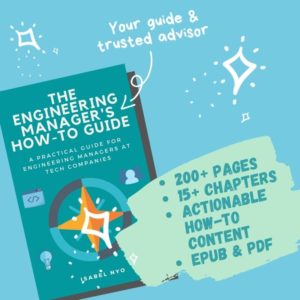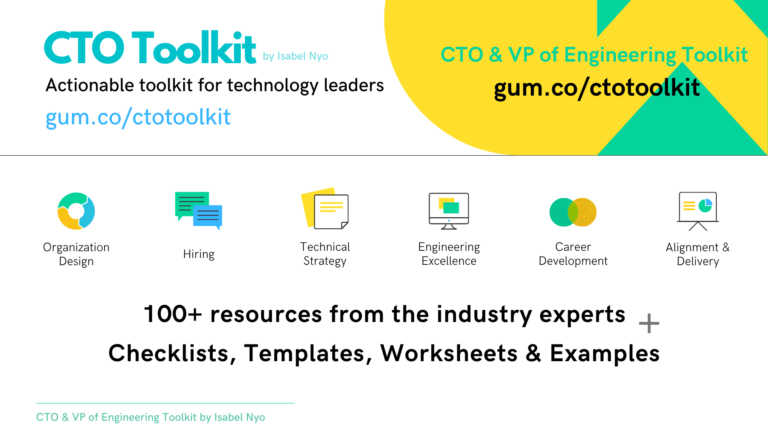To make sure you have time for impactful work instead of spending endless hours on administrative tasks
We've all heard of the timeless advice for business owners and entrepreneurs; work ON your business rather than IN your business every day in order to be successful. What if I told you that the advice is true for engineering managers as well. We are in the midst of technology transformation, software is now the centre of every business and we are seeing first hand how technology is used to accomplish various tasks in every industry, from purchasing your grocery to getting health care.
But as an engineering manager, you may forget that you can and you should leverage technology in your job to help you streamline and save time every week. When you're not busy trying to stay on top of every single pull request that your developers had merged, getting to Inbox zero, or scheduling meetings, you will have more time for impactful work, such as putting together a strategy for innovation, identifying and eliminating inefficiencies and most important of all, having the mental space to think about career growth of your people and your own.
In this article, I'm going to share with you how you can create automation and processes to generate new and efficient workflows in your role as an Engineering Manager.
Work Management Automation
Engineering managers are people managers and technical leaders for software developers and are responsible for technical delivery teams. Therefore, you need to enable your teams to deliver value efficiently. This doesn't mean becoming a micro-manager and looking at what each developer is spending their time on every hour of the day. This means providing a clear context, setting expectations, and having a mechanism to move work forward.
Having work management automation will help you ensure work is progressed to the next stage automatically and surface information about your team member's workload, activity, and capacity:
- Continuous Integration and Deployment (CI/CD) so code is not just sitting in a developer's machine, but it gets out there. Bake in necessary stages such as staging, acceptance testing, production rollout, in your CI/CD as necessary.
- Automatic reports that will give you an overview of your team's workload, activities and capacity. This will reduce the time and effort needed from you to identify bottlenecks and priorities. The visibility will also help you communicate with stakeholders and manage their expectations well.
Email Automation
- Filtering rules for grouping emails into relevant categories; for example, Vendor management, Hiring, Product, Learning, FAQs.
- Auto-responders for all the FAQs
- Canned responses and snippets; for example, introduction paragraph in your email when you respond to vendors, links to documents when getting questions about company's leave policy, learning & development budget, etc.
Scheduling Automation
- Have bookable blocks of time in your calendar for ad-hoc meetings such as interviews, mentoring, social catchups, and so on. This eliminates the need for finding a suitable time in your calendar and doing a back and forth with the other party.
- Set up "repeat" calendar events for meetings that happen at regular intervals; for example, 1:1's, growth conversations, performance reviews, standups, backlog groomings, sprint reviews, etc.
Process Automation
As engineering managers, there are things that you do that may not happen every day or every week but they happen more than once that having procedures, checklists, and reusable templates in place saves you time.
At the very least, an engineering manager should have the following templates and checklists:
- Checklist for hiring
- Onboarding plan a new hire
- Job descriptions templates
- Templates for growth conversations and performance reviews
- Standard procedures for the team and team members; eg: How to start a sprint, How to run a retrospective, how to tirage bugs, how to manage incidents and outages, how to request for leave, how to roll out a feature, and so on. When there are best practices and templates to follow, your team will know what's expected in each situation without having to depend on you.
Automate like a boss
Whether you're a seasoned engineering manager or a new engineering manager, building automation systems in your job is key to increasing your efficiency and helping you delegate tasks that do not require your expertise.
As a result, you will get to work in your zone of genius, have time for things that matter, which are usually important but not urgent and your company will move forward. Moreover, you won't be the bottleneck in your team's process or delivery.
---
If you enjoyed this article, you might like to check out my latest book on engineering management.
 A practical guide for engineering managers at tech companies
A practical guide for engineering managers at tech companies
The Engineering Manager's How-to Guide is very targeted for engineering managers, and in this book, you won't find generic advice like having regular 1:1's, giving feedback, etc. Yes, those things are absolutely important, but they are not specific to an engineering manager's role. It's my goal to make sure this book provides a concise and actionable guide for engineering managers, the specific and niche content for engineering managers that you won't find in other leadership and management books.
